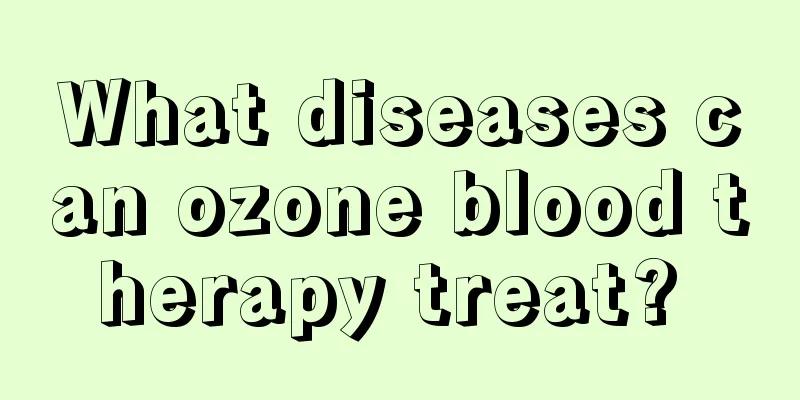What diseases can ozone blood therapy treat?

|
Ozone is a word we often hear. It is an allotrope of oxygen, and it is a good oxidant with strong oxidizing ability. Ozone blood therapy is a treatment method that draws blood from the body, filters it through ozone to kill pathogenic microorganisms in the blood, and then injects the blood back into the human body. So what diseases can ozone hemotherapy treat? 1. The following are the diseases that can be treated with ozone combined with traditional treatments: 1. Chronic ischemic diseases (brain, heart). Ozone can exert beneficial therapeutic effects. Because: A. Improve the transport of oxygen, glucose and ATP in ischemic tissues; B. Enhance angiogenesis and promote the engraftment of hematopoietic stem cells, thereby improving new blood vessel formation and tissue regeneration; C. Induce preconditioning phenomenon by upregulating the expression of antioxidant enzymes and heme oxygenase I; D. Trigger neuronal mediator responses and improve quality of life. Experiments show that for patients with advanced heart disease who are no longer suitable for transplantation or surgical angioplasty, combining ozone therapy with conventional treatment can improve patient outcomes. 2. Orthopedic diseases. Ozone disc injection can achieve a success rate of about 75% and is one of the few advanced methods that can solve herniated disc in a minimally invasive way. It also has a two-thirds effectiveness rate in treating osteoarthritis and tendinitis, and the effective mechanism is related to the activation of the anti-injury system. 3. Acute and chronic infectious diseases, bacteria, viruses and fungi resistant to antibiotics or chemotherapy. Even parasitic infections, such as giardiasis and cryptosporidiosis, are treated with ozone oil by doctors in Cuba. 4. Emergency situations, such as multiple organ failure and death following extensive trauma, burns, acute peritonitis, and sepsis. Combining the best conventional treatment with ozone autologous blood therapy 3 to 4 times a day can avoid or reduce the progression of metabolic damage and reduce mortality. In addition, patients waiting for an organ can undergo 6 to 8 sessions of ozone autologous hemotherapy between 6 and 15 days before surgery to improve resistance to infection and improve immunosuppression (due to anesthesia or surgery). At the same time, it can reduce ischemia-reperfusion injury after organ transplantation. Other general surgeries can also use ozone therapy as a preparatory treatment before surgery. 5. Osteomyelitis, empyema, peritonitis, abscesses, bedsores, chronic ulcers, diabetic foot, burns, infected wounds, candidiasis, onychomycosis. The above diseases are often accompanied by antibiotic-resistant bacteria. Lack of antibiotic penetration of infected areas, such as methicillin-resistant Staphylococcus aureus, has been linked to many deaths in developed countries. In such cases, ozonated autologous hemotransfusion therapy and topical application of ozonated olive oil or sunflower oil have a rapid antimicrobial effect and incredibly accelerate wound healing. Unfortunately the application of ozone oil is almost unknown. Interestingly, ozone, a very unstable gas, can be combined with unsaturated fatty vegetable oils to form a stable ozonide. When ozonated oil is applied to the exudate from the wound surface, the ozonated oil reacts with biomolecules to generate and release stable hydrogen peroxide. The disinfecting action and improved oxygenation can accelerate scar formation. Conventional ointments often contain useless antibiotics and growth factors. Once ozonated oil is known and used by people, it will have a great therapeutic effect on millions of patients. 6. Herpes virus infection (HHVI and II), herpes zoster, and papillomavirus infection. Ozone therapy using intramuscular injections of small amounts of autologous blood as a font vaccine combined with topical application of ozonated oil is very effective in preventing recurrences of herpes. This approach, especially when combined with acyclovir, can cure most herpes infections. At the same time, it also has a very good effect on reducing herpes zoster infection and neuralgia after infection. 7. Chronic hepatitis and HIV infection must be treated with interferon or active antiretroviral transcriptase respectively if possible, because these drugs can often reduce the viral load. However, ozone can be a useful adjunct therapy in the meantime. 8. Autoimmune diseases (multiple sclerosis, rheumatoid arthritis, Crohn's disease). Autologous blood therapy is very encouraging. 9. Degenerative diseases. Autologous blood therapy can improve patients with early-stage Alzheimer's disease. On the other hand, it has little effect on diabetic retinopathy, retinitis pigmentosa, sudden deafness, and chronic tinnitus. 10. Lung diseases (emphysema, asthma, COPD, acute respiratory distress syndrome). The treatment principles for COPD are as follows: A. Blood transfusion: lipid oxides can act on the surface of endothelial cells, increasing the release of prostacyclin and NO, while the release of endothelin I is inhibited. The release of NO and nitrosothiols promotes vasodilation, while the release of anion superoxide causes vasoconstriction and has a negative impact on platelets and endothelial cells; B. Enhanced oxygen delivery to ischemic tissues, enhanced antioxidant enzymes, and heme oxygenase I neutralize chronic oxidative stress. C. Stimulation of the immune system can control chronic lung infections. Good results can be achieved with ozone therapy for COPD, including improvements in respiratory function and walking test. 11. End-stage renal disease is aggravated by chronic oxidative stress and cannot be controlled by traditional drugs. Ozone therapy stabilizes severe functional disorders and improves the patient's quality of life. 12. Ozone autologous blood transfusion therapy combined with topical application of ozone oil has been shown to be very effective for metabolic syndrome, such as refractory chronic ulcers in patients with type 2 diabetes. Controlling blood sugar levels is a must. 13. Skin diseases (psoriasis, atopic dermatitis). 14. Metastatic cancer resistant to chemotherapy drugs and cancer fatigue. Ozone therapy can improve the patient's quality of life, but it cannot stop the development of cancer. On the other hand, ozone therapy is very effective after surgery, not only by inducing antioxidant responses, but also by The effects of cytotoxic drugs should be enhanced and the toxicity of chemotherapy drugs can be reduced. 15. Chronic fatigue syndrome and fibromyalgia. Autologous blood therapy has been found to be effective in most patients. 16. Dentistry. Ozone is very effective in treating tooth root decay damage. Ozone oil for the treatment of aphthous ulcers and pain relief 2 Pharmacological effects of ozone autohemotherapy 2. Three activations: 1. Activate red blood cell metabolism, increase the oxygen saturation of hemoglobin, and enhance the utilization of oxygen and ATP by tissues; 2. Activate the body's immune system, increase the number of white blood cells in the blood, enhance the ability to phagocytize bacteria, increase the number of T lymphocytes to 204%, and increase the number of active T lymphocytes by 70%; 3. Activate the antioxidant enzyme system, increase the level of 6-keto-prostaglandin F1 in plasma, enhance the activity of antioxidant enzymes in the body, and reduce the damage of free radicals to the body. 3. Four improvements: 1. Improve blood rheology, increase blood alkaliphilic granulocytes, increase the level of free heparin in the blood, reduce red blood cell aggregation, and enhance deformability; 2. Improve microcirculation, reduce cerebral edema, and regulate the functional state of cerebral blood vessels; 3. Improve blood substance metabolism, reduce blood sugar, uric acid, bilirubin, lactic acid, pyruvic acid, and reduce lipid peroxide malondialdehyde (MDA) and thromboxane B2 (TXB2); 4. Improve the condition of blood vessel walls, reduce platelet aggregation, and decrease blood viscosity, thereby improving the condition of blood vessel walls. 4. Treatment steps: The nurse takes 100 ml of the patient's cubital venous blood and mixes it with a pre-set O3 concentration (47 μg/mg) in a 1:1 ratio. After 5-10 minutes of mixing, the blood has been fully ozonated. Finally, it takes about 15 minutes to return the blood to the patient. |
<<: Will my face become smaller after wisdom teeth removal? How to pull it out?
>>: What to do if you have pain in your groin area?
Recommend
How to treat hepatitis A_How to treat hepatitis A
Hepatitis A is a relatively common liver disease....
What is the survival rate of malignant breast cancer
What is the survival rate for aggressive breast c...
Does drinking tea really cause spots?
Nowadays, few young people have the habit of drin...
Treatment of esophageal cancer with modified Erchen decoction
The symptoms of esophageal cancer patients are ge...
What is Mycoplasma pneumoniae infection?
Mycoplasma pneumoniae infection is generally a co...
What symptoms are symptoms of uterine cancer
What is uterine cancer? Cervical cancer is one of...
Is prostate cancer harmful? Will prostate cancer metastasize to the kidneys?
Prostate cancer is a relatively inflammatory dise...
Can a routine gynecological examination detect ovarian tumors?
Ovarian tumors refer to tumors that occur on the ...
Can I swim if I have urticaria
Urticaria is a very common disease with many caus...
Beware of hypoglycemia symptoms in liver cancer patients
A small number of liver cancer patients will expe...
Can prostate cancer cause infertility?
Will prostate cancer cause infertility? Chronic p...
Can patients with malignant ovarian cancer exercise?
The increasing pressure from work and life has ca...
Buckwheat tea and wolfberry
Buckwheat tea and wolfberry can be consumed toget...
What is the treatment for nasopharyngeal carcinoma bone metastasis? Can nasopharyngeal carcinoma bone metastasis be cured?
What is the treatment for bone metastasis of naso...
Adolescent's heart suddenly stabbed
Teenagers are generally healthier both physically...









